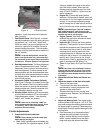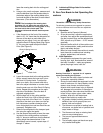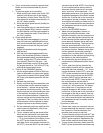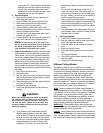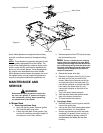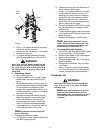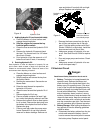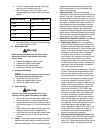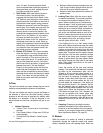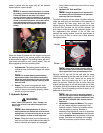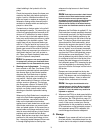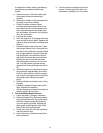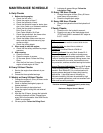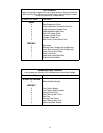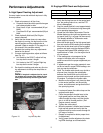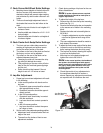21
start. If it does, the parking brake switch
must be repositioned or perhaps replaced. If
the engine does not start, engage the park
-
ing brake and start the engine.
c. Seat Switch: With both steering levers in
the neutral position, the parking brake
engaged and the blade clutch switch in the
“off” position, start the engine. Now release
the parking brake, hold down on the back of
the operator’s seat against spring pressure.
Release the operator’s seat and the engine
should stop. If the engine does not stop, the
seat switch must be replaced. With both
steering levers in the neutral position, the
parking brake engaged and the blade clutch
switch in the “off” position, sit in the opera
-
tor’s seat and start the engine. Turn the
blade clutch switch to the “on” position and
the blades should start to rotate. Raise up
slightly off the operator’s seat and the blades
should stop. If the blades do not stop when
you dismount from the operator’s seat, the
seat switch must be replaced.
d. Electric PTO Clutch: This clutch operates
when the engine is running, the operator is
in the operator’s seat and the blade clutch
switch is turned on.This electric clutch is a
fairly trouble free device. If a problem devel
-
ops and the blades do not turn, first check
the 20 amp fuse in the yellow, 16-gauge wire
between terminal “L” (for the Gasoline
Engine) on the ignition switch and the hour
meter and then investigate the wiring har
-
ness and the connections to the seat switch,
the blade clutch switch and the electric blade
clutch. Then check out the seat switch, the
blade clutch switch and finally the electric
blade clutch.
D.Tires
The two front wheels are caster wheels that are free to
swivel to accommodate the direction of the Mower.
The two rear wheels are used to propel the Mower in
the direction of input from the drive handles. Inflation
pressure of the rear tires is important for stability while
the Mower is in operation. If the tire diameter is not
equal between the two tires, the Mower will pull to one
side.
1.
Inflation Pressure:
a. Traction Tires—20 psi max; 8-10 psi recom-
mended
b. Front Caster Wheel—28 psi max; 20-25 psi
recommended
c. Cutting Deck Ball Wheels—Solid Polyure-
thane.
Use the Following guidelines for maintaining the tires:
a. Balance inflation pressure between the rear
tires to help maintain straight travel (see tire
side wall for proper inflation pressure).
b. Keep the valve caps tightened to prevent air
pressure loss.
2.
Leaking Tires:
When a flat tire occurs, repair
or replace immediately. The normal procedure
is to remove the wheel and replace it with a
spare. Take the leaking tire to a maintenance
area and repair. If a tire is getting soft, park the
mower on the nearest level, paved area. If the
leaking tire is on a traction wheel, put blocks on
each side of the opposite traction wheel and
jack up the tire that leaks about an inch off the
ground. Loosen and remove the lug nuts and
remove the wheel. Mount a spare wheel and
tire, replace the lug nuts, and using a torque
wrench, tighten them to 60
±
10 lb-ft.
If the leaking tire is on a front caster wheel,
block both traction wheels and raise the caster
wheel so that the tire is an inch off the ground.
Loosen and remove the locknut from the axle
assembly and pull the axle assembly from the
caster yoke. The wheel and two spacer sleeves
will drop free. Slip the axle assembly through
one side of the caster yoke, through a spacer
sleeve, a spare wheel, the other spacer sleeve
and finally through the other side of the caster
yoke. Then tighten the locknut on the end of
the axle assembly.
Lower the mower off the jack and continue
mowing. The wheel with the leaking tire should
be taken to the maintenance area, the tire
inflated to 20 psi and the wheel placed in a
large bucket of water. Carefully inspect the tire,
rim and valve for escaping air bubbles which
indicate a leak. Mark each leak with a yellow
marking crayon and then deflate the tire to 8
psi and repeat the inspection. If the leaks you
find are pin hole size to 1/16" diameter, the tire
can be repaired using an aerosol can of tire
inflater and latex sealer available from any auto
supply store. Follow the directions on the can.
If the leaks are larger than 1/16" diameter, the
tire can be repaired with rubber plugs also
available in a kit from any auto supply store. If
the tire bead is damaged, a tube will have to be
installed in the tire or the tire will have to be
replaced.
3.
Creeping:
Creeping is the slight forward or
backward movement of the mower when the
throttle is on and the lapbars are in the neutral
position. If your mower creeps refer to Steering
lever Adjustments Section F4, page 23.
E. Brakes
While the mower is in motion, all braking is performed
dynamically through the hydraulic pumps and traction
motors, controlled by the two steering levers. When the



